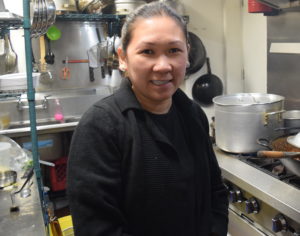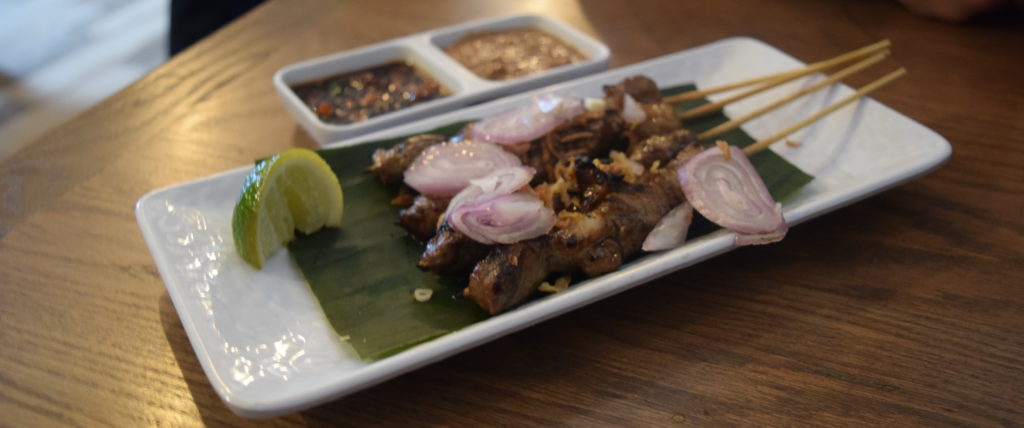Foodizen: Satay in the City
Foodizen: Satay in the Metropolis
The serial on the nexus of food and culture looks at satay, a window into Philly's substantial Indonesian community
Feb. 06, 2019
Satay, by now, is so much a function of American food culture that in that location'south rarely a hymeneals or other fancy catered consequence that doesn't feature some kind of bland chicken-on-a-stick appetizer, forth with peanut sauce. I'one thousand erstwhile enough to recall when satay started condign popular in the 1980s, with the rise of Thai and fusion restaurants. It speedily went from unknown to the most accessible, crowd-pleasing "Asian" dish that Americans enjoy. Satay is then mainstream and taken for granted, that when you lot taste a bite of the existent, accurate thing, prepared by an Indonesian or Malay melt, the experience can be surprisingly transcendent.

That wonderful experience is widely available in South Philadelphia, which is a neighborhood rich in authentic satay (or saté). There's, of course, Hardena , the apprehensive, cafeteria-style Indonesian food institution at the corner of Hicks and Moore Streets (well-nigh 15 thursday ), where Ena Widjojo, and her daughters Maylia and Diana, has been serving up soulful lamb and craven satay since 2001. Then there's the trendy Saté Kampar on East Passyunk, where crowds of young hipsters consume delicious Malaysian-fashion saté from chicken, beefiness, pork, goat, and tofu sizzled over charcoal made from kokosnoot shells, and served with both spicy peanut sauce and a Hainan-style peanut-pineapple sauce.
Indonesians and Malaysians will endlessly fence which Southeast Asian civilization actually invented satay, but in S Philly, the Indonesians may likely win the argument due to numbers: Philadelphia, later all, has one of the highest Indonesian populations of whatsoever city in the U.Due south. (the number of Indonesian immigrants more than than doubled nationwide between 2000 and 2015).
"This neighborhood is very Italian, I see some of my neighbors speaking Italian," Ho says. "But they come in here and they're non afraid to attempt Indonesian food."
There's fifty-fifty a local weekly Indonesian newspaper here, chosen KabarKilat , that ![]() y'all can find in restaurants that take been serving the community for years, such as Heaven Cafe , Indonesia Eatery (which also owns the Pendawa grocery) and Ramayana , the beloved cafeteria-style spot that also doubles every bit a grocery. The community'southward spiritual centre is the Masjid Al Falah mosque at 17th and Tasker, home to the Indonesian Community of Greater Philadelphia (Indonesia has the world's largest population of Muslims). Indonesian independence day is even celebrated each Baronial in South Philadelphia.
y'all can find in restaurants that take been serving the community for years, such as Heaven Cafe , Indonesia Eatery (which also owns the Pendawa grocery) and Ramayana , the beloved cafeteria-style spot that also doubles every bit a grocery. The community'southward spiritual centre is the Masjid Al Falah mosque at 17th and Tasker, home to the Indonesian Community of Greater Philadelphia (Indonesia has the world's largest population of Muslims). Indonesian independence day is even celebrated each Baronial in South Philadelphia.
My favorite Indonesian spot is a relative newcomer, the cozy D'Dki jakarta Cafe , at the corner of 16 th and Ritner, opened about a twelvemonth and half ago by 36-year-sometime Alfitri Ho and her husband Beddy Sonie—with Ho's female parent, Cararina, as chef. The Hos immigrated to Philadelphia from Jakarta when Alfitri was xvi years former.

Back home, Cararina ran 3 restaurants in Indonesia'southward humming capital metropolis, including street-food stalls that specialized in satay. Cararina's parents, hailing from Borneo, were of Chinese descent, simply when they moved to Jakarta during the regime of dictator Suharto, they changed their Chinese name to Indonesian. When Cararina arrived in Philadelphia in the late 1990s, she worked in a factory, but was well-known within the tight-knit Indonesian community equally a great melt. When Alfitri made a trip back to Indonesia in 2015, she was inspired to open D'Dki jakarta Cafe and put her mother back in the kitchen.
"I want to help build our community," Ho says. "Our generation, the kids, we desire to let people know that we are Indonesian and to showcase our culture." In that way, Ho shares similar goals with the Lao Food Movement that we wrote about last calendar week.
"I want to help build our community," Ho says. "Our generation, the kids, we want to permit people know that nosotros are Indonesian and to showcase our civilisation."
"People used to inquire, 'Where are yous from?' and when I said 'Republic of indonesia,' they asked: 'Where is Republic of indonesia?'" Ho says. "I could encounter people scared to try our food because they weren't familiar with it." Satay was a natural bridge to the cuisine. "How can you get wrong with grilled chicken?"
Now, Ho says, people are getting more than familiar with Indonesian food. "This neighborhood is very Italian, I run across some of my neighbors speaking Italian," she says. "But they come in here and they're not afraid to effort Indonesian food."

The unabridged menu at D'Djakarta Cafe is worth exploring. In item their beefiness rendang—beefiness shanks slowly braised in coconut milk for hours and infused with spices and herbs and served on a banana leaf—is one of the best renditions I've tasted. Just the satay hither is something special, a lilliputian saucier than Saté Kampar, less sweet than Hardena, Ho's satay is influenced by Jakarta, which she says is "kind of a melting pot of everything" and grows out of that street culture. "In Jakarta, we always bought satay from a street vendor," she says. "We rarely bought satay from a restaurant."
![]()
The satay technique hither is a little different than others, and Ho lets me poke my caput into the kitchen to observe. On this 24-hour interval, her brother Yanuar is working the satay grill. "He used to be a sushi chef, but now he's becoming an Indonesian chef," she says.
For the chicken, the "peanut sauce" is actually a spicy mix of peanuts and candlenuts, ground upwards along with fresh lime leaves, shallots, onions, garlic, and lime juice. The grilling takes nigh ten minutes or more, with skewered chicken thigh meat dipped several times during the process, creating carmelizing layer after layer. They also make a tasty lamb satay, that's similarly dipped throughout the process with butter, garlic, and Indonesian sugariness soy sauce. That sugariness soy is also used to brand a dipping sauce called sambal kecap, which marinates for 24 hours with green chilies, tomatoes and lime, and is served alongside the lamb satay. The event of all this is very circuitous satay, about as far away as imaginable from what yous may accept eaten off the wedding caterer's tray.
"In Republic of indonesia, satay is non an appetizer," Ho says. "But when satay came over hither, we had to fit into the American organisation. So we adapted, and satay became an appetizer."
Now that the dish has become so mainstream, it serves as a sign that Indonesians take found their place here in the cloth of the city, and possibly also offers an accessible introduction for those of us who'd like to learn more.
Jason Wilson is The Citizen's 2022 Jeremy Nowak Fellow, funded by Spring Point Partners, in honor of our late chairman Jeremy Nowak. He is the author of three books, including most recently Godforsaken Grapes, serial editor of The Best American Travel Writing, and writes for the Washington Post, New York Times, New Yorker and many other publications.
Photo by Tim Toohey 



lopezcapperes1964.blogspot.com
Source: https://thephiladelphiacitizen.org/foodizen-satay-in-the-city/
0 Response to "Foodizen: Satay in the City"
Post a Comment